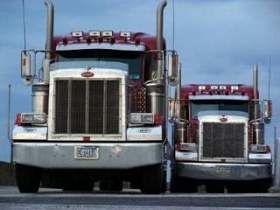Review Questions - Click On The Picture To Begin...

- Keep the right turn signal activated
- Be sure you're not blocking any road signs
- Place the truck into a low gear before releasing the clutch
- Set the trailer brakes only
Quote From The CDL Manual:
Once stopped:
- Vehicle must be parallel to the curb or shoulder of the road and safely out of the traffic flow.
- Vehicle should not be blocking driveways, fire hydrants, intersections, signs, etc.
- Cancel the turn signal.
- Activate the four-way emergency flashers.
- Apply the parking brake.
- Move the gear shift to neutral or park.
- Remove your feet from the brake and clutch pedals.
- Make necessary traffic checks
- Change lanes when it is safe to do so
- All of these answers are true
- Use proper signals
Quote From The CDL Manual:
You will be instructed to change lanes:
- Make necessary traffic checks.
- Use proper signals.
- Change lanes smoothly when it is safe to do so.
TruckingTruth's Advice:
The examiner will ask you to make a lane change, but you're expected to perform the lane change safely. The examiner will not check for traffic before asking you to make the lane change.
- Leave the truck in gear, but depress the clutch pedal to avoid stalling while slowing down
- Decelerate quickly without changing gears
- Place the transmission in neutral before braking
- Bring your vehicle to a full stop without coasting
Quote From The CDL Manual:
As you prepare for the stop:
- Check traffic.
- Activate your right turn signal.
- Decelerate smoothly, brake evenly, change gears as necessary.
- Bring your vehicle to a full stop without coasting.
TruckingTruth's Advice:
Always slow down smoothly and use downshifting to slow the vehicle. You never want to be out of gear or leave the clutch pedal depressed while slowing down.
- Slow down before entering the curve as to avoid braking or shifting during the curve
- Depress the clutch pedal and coast through the turn
- Continue slowing down during the curve, and downshift about half way through the curve
- Continue to slow down throughout the entire duration of the curve
Quote From The CDL Manual:
When approaching a curve:
- Check traffic thoroughly in all directions.
- Before entering the curve, reduce speed so further braking or shifting is not required in the curve.
- Keep vehicle in the lane.
- Continue checking traffic in all directions.
TruckingTruth's Advice:
Always slow down and get into the correct gear before the curve and never shift during the curve. It's better to slow down too much than not enough.
- After you have re-entered the traffic lane
- Before rolling forward to re-enter the traffic flow
- For approximately 30 seconds after re-entering traffic flow
- Once you are in the traffic lane and up to highway speeds
Quote From The CDL Manual:
When instructed to resume:
- Check traffic and mirrors thoroughly in all directions.
- Turn off the four-way flashers.
- Activate the left turn signal.
- When traffic permits, release the parking brake and pull straight ahead.
- Do not turn the wheel before your vehicle moves.
- Check traffic from all directions, especially to the left.
- Steer and accelerate smoothly into the proper lane when safe to do so.
- Once your vehicle is back into the flow of traffic, cancel the left turn signal.
TruckingTruth's Advice:
Before you begin moving forward, you should activate the left turn signal so other motorists know you're getting ready to re-enter the traffic lane.








 TT On Facebook
TT On Facebook